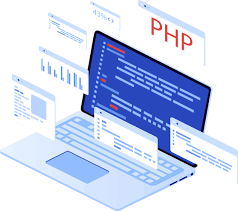info@gladsme.in
+91.8891968718
Mastering PHP Development: Building Dynamic Websites with Power and Precision
Mastering PHP Development: Building Dynamic Websites with Power and Precision

Welcome to the dynamic world of PHP development, where creativity meets functionality to create powerful and interactive websites. In this guide, we'll take you on a journey through the fundamentals of PHP programming, exploring its versatility and potential to build dynamic web solutions.
Understanding the Basics of PHP
PHP, which stands for Hypertext Preprocessor, is a server-side scripting language widely used for web development. It's renowned for its simplicity, flexibility, and vast community support. Before diving into advanced topics, it's essential to grasp the basics of PHP syntax, variables, data types, and control structures.
Building Dynamic Websites with PHP
One of PHP's primary strengths lies in its ability to generate dynamic content. Whether you're creating a simple contact form or a complex e-commerce platform, PHP empowers developers to build interactive websites that respond to user input and deliver personalized experiences.
Interacting with Databases
No dynamic website is complete without a robust database backend. PHP seamlessly integrates with popular database management systems like MySQL, PostgreSQL, and SQLite, enabling developers to perform database operations such as querying, inserting, updating, and deleting data. Leveraging PHP's database connectivity features, you can create dynamic web applications that store and retrieve information efficiently.
Handling Forms and User Input
Forms are ubiquitous in web development, serving as a means for users to interact with web applications. PHP provides powerful mechanisms for processing form data, validating inputs, and safeguarding against security threats like SQL injection and cross-site scripting (XSS). By mastering form handling techniques in PHP, you can create secure and user-friendly web forms that enhance the overall user experience.
Exploring PHP Frameworks
While PHP offers immense flexibility for building web applications from scratch, leveraging PHP frameworks can streamline the development process and enhance code maintainability. Frameworks like Laravel, Symfony, and CodeIgniter provide scaffolding tools, libraries, and conventions that simplify common tasks such as routing, authentication, and database interactions. By harnessing the power of PHP frameworks, developers can expedite development cycles and focus on building innovative features.
Securing PHP Applications
Security is paramount in web development, especially when dealing with sensitive user data and financial transactions. PHP offers various security measures and best practices to mitigate risks such as SQL injection, cross-site scripting, and session hijacking. From input validation to implementing secure authentication mechanisms, understanding PHP security principles is essential for safeguarding your web applications against potential threats.
Embracing Continuous Learning and Improvement
PHP development is a journey of continuous learning and improvement. As technology evolves and new trends emerge, staying updated with the latest PHP features, tools, and best practices is crucial for staying ahead in the competitive web development landscape. Whether through online tutorials, community forums, or hands-on projects, never stop exploring and honing your PHP skills.
In conclusion, PHP development offers a rich ecosystem for building dynamic, feature-rich web applications that delight users and drive business outcomes. By mastering the fundamentals of PHP programming, harnessing the power of frameworks, and prioritizing security and best practices, you can unlock endless possibilities in web development. So, roll up your sleeves, dive into the world of PHP, and embark on a journey of innovation and creativity in building dynamic websites that make a difference.
Related Blogs

The Importance of Data Structures in Software Development
Read More...
Exploring Machine Learning Algorithms: A Beginner's Guide
Read More...
The Evolution of Programming Languages: From Assembly to Rust
Read More...
Understanding Big O Notation: A Guide for Developers
Read More...Subscribe for our Newsletter
Subscribe to elevate your software game! Stay updated on the latest trends, coding insights, and exclusive promotions with our newsletter.
